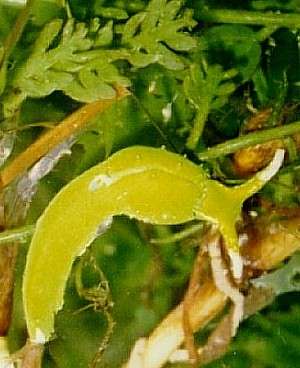
Oxynoe sp. 1
Order: SACOGLOSSA
Superfamily: OXYNOOIDEA
Family: Oxynoidae
PHOTO
From aquarium shop, 1998, in Brasil. 28 mm long alive. PHOTO: Carlo Magenta-da-Cunha.
RELATED TOPIC
See messages below.
Authorship detailsRudman, W.B., 2000 (April 9) Oxynoe sp. 1 [In] Sea Slug Forum. Australian Museum, Sydney. Available from http://www.seaslugforum.net/find/oxynsp1
Related messages
Re: Another aquarium mystery
October 22, 2000
From: Rob Dahrling
With your help I have identified my "sea slug" as Oxynoe sp. 1, but still don't quite understand if this is an Atlantic or Pacific species. Can you tell me in which ocean it is normally found?
Thank you,
Rob Dahrling
robdgrow@juno.com
Dahrling, R, 2000 (Oct 22) Re: Another aquarium mystery. [Message in] Sea Slug Forum. Australian Museum, Sydney. Available from http://www.seaslugforum.net/find/3222Dear Rob,
I'm afraid the one you've identified your animal with is one found in an aquarium and we don't know where it originated from either. It was found in a Brazilian aquarium and looks quite like a Caribbean species, but as Tropical Pacific species have also been found in Brazilan pet shops there is no way to be sure of its origin.
As you will see from the species list, there are species of Oxynoe in both the tropical Atlantic and the Pacific, and they are all quite similar in colour and shape. To identify your animal to a particular species, would not be easy.
Best wishes,
Bill Rudman.
Another aquarium mystery
October 18, 2000
From: Robert Dahrling
I have discovered a nudibranch in my 29 gal. mini reef tank. It is only 1/2 to 3/4 inch long. It is lime green, but its antenna have white tips and the tip of it's tail is also white. It has short yellow bristles along it's dorsum. I find it a lot in macroalgae, especially Caulerpa. Can you identify it from this description and tell me if you think I have an herbivore or carnivore?
Thanks,
Rob
robdgrow@juno.com
Dahrling, R., 2000 (Oct 18) Another aquarium mystery. [Message in] Sea Slug Forum. Australian Museum, Sydney. Available from http://www.seaslugforum.net/find/3135Dear Rob,
You haven't given me any clues to where in the world your animal may have come from or much about its shape. However, since you say it is mostly green and prefers Caulerpa then you probbaly have a sacoglossan sea slug. Sacoglossans are all herbivores, sucking the sap out of the algae they feed on much like bugs suck the sap out of plants on land. They are sea slugs but they are not nudibranchs. They shouldn't cause any problems in your aquarium although they will eat a bit of Caulerpa.
Have a look at some of the species in the Species List in the Order Sacoglossa. A couple of possibilities would be a species of Oxynoe which still has a transparent shell, or a species of Elysia which are often green.
Best wishes,
Bill Rudman.
Re: Oxynoe sp from West Atlantic?
April 10, 2000
From: Kathe R. Jensen
Dear Carlo Magenta,
The Caulerpa you have on your photos looks uncomfortably similar to Caulerpa taxifolia, which is a pest in the Mediterranean. It has adapted its physiology to aquarium conditions (low light intensity, cool temperatures), and was accidentally released near Monaco in the early 1980s. There is a group of scientists trying to establish a total ban on aquarium trade of this alga, so you should tell the aquarium owner to be very careful about disposing of surplus algae - and certainly stop selling it! There are a number of web-pages where you can get more information about the spread and attempts to control this alga in the Mediterranean (unfortunately I can't remember them off the top of my head, but they are easy to find).
The Oxynoe may very well be the Mediterranean Oxynoe olivacea, which usually has few papillae, but usually some dark blue or brown spots - but colouration varies. Did you get a closer look at the eggs? They can at least be used to separate out one of the Caribbean species, Oxynoe azuropunctata, which has large egg capsules and lecithotrophic (non-feeding, poorly swimming) larvae.
Kathe R. Jensen
jensen@ait.ac.th
Jensen, K.R., 2000 (Apr 10) Re: Oxynoe sp from West Atlantic?. [Message in] Sea Slug Forum. Australian Museum, Sydney. Available from http://www.seaslugforum.net/find/2244Thanks Kathe,
Do you know where Caulerpa taxifolia was introduced from?
Bill Rudman.
Oxynoe sp from West Atlantic?
April 5, 2000
From: Carlo Magenta-da-Cunha


This specimen of Oxynoe viridis was founded feeding on a species of Caulerpa. This seaweed was for sale in a shop of aquarium fish in 1998, here in Brasil.
This specimen was 28 mm, and together had others specimens in some step of development and eggs.
The person couldn't tell me where the seaweed came from.
Congratulations for the Forum! :=)
Magenta
carlomagenta@uol.com.br
Magenta-da-Cunha, C., 2000 (Apr 5) Oxynoe sp from West Atlantic?. [Message in] Sea Slug Forum. Australian Museum, Sydney. Available from http://www.seaslugforum.net/find/2189Dear Magenta,
Thanks for the photos. I guess we can't even say this is from the Atlantic - Caribbean region. It does have similarities to the west Atlantic Oxynoe antillarum but I don't know if the Caulerpa is a west Atlantic species.
I think all Oxynoe viridis I have seen have some blue spots on them and your animal doesn't seem to have any so perhaps it is an Atlantic species.
Best wishes,
Bill Rudman.
